A power outage can happen whether you are hooked up to the grid, run your own off-grid electrical setup, or both. This is why it is important to have a tin oil lamp ready to go in times of need.
Since electrical outages always happen at the worst possible time, imagine yourself trying to make a tin oil lamp in the pitch black of night. This is going to be a challenge at best.
Since making an oil lamp is relatively straightforward and quick, get a few ready to go so they are available when needed.
Making A DIY Tin Oil Lamp
Making a tin oil lamp is easy if you have an old, empty metal paint or lacquer can laying around ready to be repurposed.
Related: How To Repurpose Old Items Into New Projects For Your Backyard
In combination with a cloth wick that can be created out of an old rag, t-shirt, or cotton string, the construction of a DIY tin oil lamp is quick and free.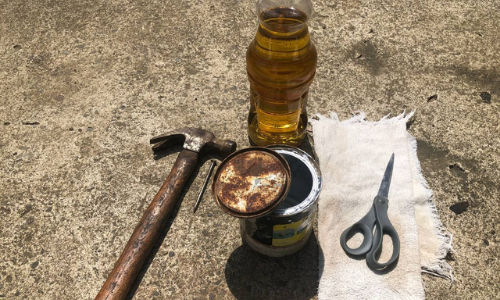 After inserting the wick into the cover of the tin can, add some vegetable oil, preferably old, used oil, as it likely won’t be used for anything else and doesn’t cost anything.
After inserting the wick into the cover of the tin can, add some vegetable oil, preferably old, used oil, as it likely won’t be used for anything else and doesn’t cost anything.
You can also use kerosene, high-proof alcohol, or diesel fuel with this type of tin oil lamp set up, however, vegetable oil is the safest and doesn’t produce much smoke.
After adding the fuel, wait for the wick to be fully saturated in the flammable material, and light the wick like a candle.
Step 1 – Modify The Cover Of The Tin Can
Take a hammer and nail to puncture a hole in the top center of the tin can cover. Now, modify this hole if needed so it is just big enough to fit the cotton wick. 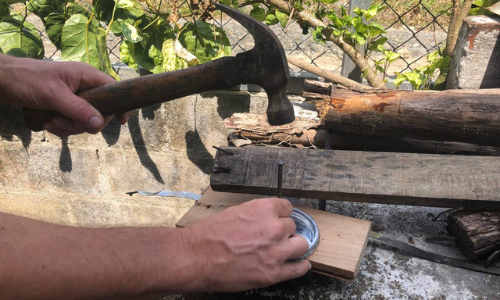
If you don’t have a cover for your tin can, you can secure a cotton wick with a metal wire at the bottom of the can so that the top of the wick remains exposed above the oil.
The overall setup is easier with a cover, as it secures the wick in place and reduces the number of materials required to create the lamp.
Step 2 – Insert A Cotton Wick Into The Top Of The Tin Can
Use a cotton string or cut an old cotton rag so a thin strip of fabric can be used as a wick. 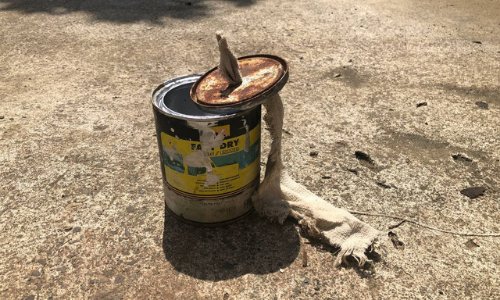
Any type of cotton or wick-like material will do here. Even a large cotton ball can be stretched out so it extends beyond the top cover and reaches the bottom of the tin can.
Related: DIY Candle Lantern From A Soda Can
In any case, the flammable material will saturate the makeshift cotton wick so a steady stream of fuel is continuously available to maintain the fire.
Just make sure that the cotton wick is long enough to reach the bottom of the container so it can access all the fuel available.
Take the cotton wick and insert it into the hole in the top of the tin can. Make sure the wick fits snugly in place while leaving about an inch of wick at the top with the rest hanging down into the bottom of the can.
Step 3 – Add Oil Or Another Fuel To The Tin Can
At this point, add a flammable oil like vegetable oil or fuel to the tin can and allow the cotton wick to become saturated in this fluid. 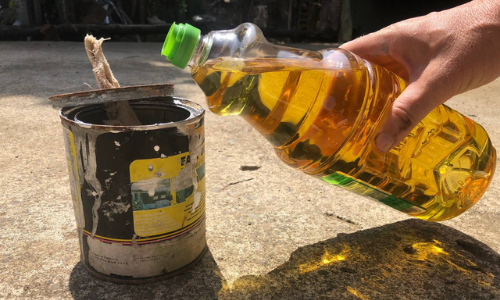
Now, snap on the cover of the tin can and ensure that the exposed wick is saturated with flammable liquid. This may take a couple of minutes for complete saturation.
If you are impatient like me, flip the lamp around a few times while securing the cover so the wick is saturated immediately.
Step 4 – Light The Wick
The wick on the tin oil lamp should quickly light up and maintain the flame. 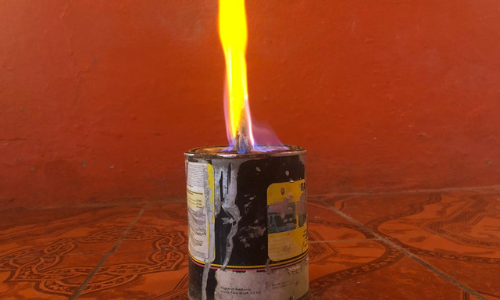
At this point, the lamp can be used for hours, as the flammable material burns efficiently and casts a flame that is strong enough to light up a room.
Refilling The Tin Oil Lamp With Fuel
When refilling the tin oil lamp with fuel, blow out the flame or suffocate the flame to extinguish it.
Then, open up the cover of the tin can and add more fuel. Snap the cover on and re-light the wick for hours of continuous light.
Cooking With A Tin Oil Lamp
If you depend on electrical power for your cooking needs, a power outage will render electrical appliances worthless. In the case of a power outage, the tin oil lamp can be used for cooking.
Related: No Gas, No Electricity… How To Cook Indoors Without Smoke
While it will take a long time to heat water or cook with such a small flame, it does offer the possibility of cooking, if no other heat source is available.
Glass Mason Jar Oil Lamp
A tin or metal container with a tight-fitting lid is the best option for an oil lamp because it won’t shatter and cause a large fire if it falls on the floor.
However, in a pinch, when a metal can is not available, a Mason jar can function similarly. Simply poke a hole in the cover of the Mason jar, add the cotton wick, fill it with fuel, screw on the top, and light the wick.
The advantage of a glass oil lamp is that it’s easy to see how much fuel is left. The huge disadvantage of a glass oil lamp is that it can shatter if dropped and cause a Molotov cocktail-like fire. In short, use a metal can if at all possible.
DIY Tin Oil Lamp In Case Of A Power Outage
A lit tin oil lamp has a nice glow to it that is relaxing and superior to electrical lighting in my opinion.
I use a tin oil lamp to light up my house at night even though I have LED lights that are connected to a solar electrical system.
After creating your tin oil lamps, make them easily accessible so they can be quickly located and lit in the event of a power outage.
You may also like:
 Your Great Depression Era Recipe for Hard Times
Your Great Depression Era Recipe for Hard Times
The Biggest Medical Mistakes You Can Make In A Blackout (Video)
How to Make A Concealment Shelf
9 Prepping Items That Have Dramatically Soared In Price Lately
When To Let The Police Intervene And When To Take Justice Into Your Own Hands

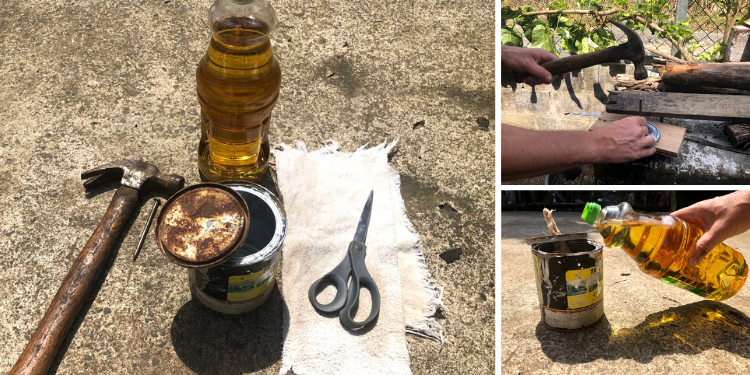













Good to have in a hard pinch.
Plus can use the old oil. Strain and store for later.
But will the old oil put off an odor. ?
Old oil will have more of a smell than new oil.
Is that an opinion based on actually burning old oil or is it just a guess? If it is based on actually burning old oil, what kind of oil and how old was it? Was it just “old” or was it actually rancid?
you’re basically fabricating the old tried & try “tiki or pot torch” – been around since the 1960s in the US outdoor entertainment arena ….
I certainly hope that the preppers reading here are better prepped for indoor illumination that there’s no need to DIY – in the very least have purchased the economical Wally World glass wick lamps and gallons of scent-free lamp oil – hopefully gone full tilt with the technology and electrically prepped for SHTFs ….
where a tiki torch type can prove useful are those outdoor areas that could use illumination – but you don’t want to possibly scacrifice something like a Coleman or Deitz lantern >> as already detailed the DIY fabrication is simple enough and made even eazier by prepping factory made wicks – fuel can be salvaged by stripping the various fluids from disabled vehicles …
I believe oil lamps have been around for, oh I don’t know, maybe a couple thousand years.
Oil lamps made of stone have been discovered 10,000 possibly even up 15,000 years ago.
I personally have oil lamps & have given as house warming gifts. However, if I ask my family or friends where lamp is during power outage. Not one still has it. Fools
?? – thought most everyone would know what a tiki torch was and got a BBQ invite at least once in their life ….
Good to know in case we are at a home of friends or family that are not prepared. Most of my family think I am crazy. But, my house is the first place they will come to if things go bad.
Be sure to ask them what they brought when they show up. “Oh, you didn’t bring anything? Here, go fill this 5-gallon can with pieces of dry wood no longer than 5 inches and no thicker than an inch in diameter. Fill it to the brim. Dont come back until it’s full.” Then shut the door.
Well there ya go Nathaniel says 10 -15, 000 years ago. … That even more than either 2000 years or 1960. ?
I’m not sure I’d want to leave them full of cooking oil. It doesn’t take long for that to go rancid and really start to smell. I can see having the lamps themselves assembled and ready to go. I can spare a few moments of flashlight battery to fill it with whatever oil I have on hand *when* the power goes out. That involves far less maintenance than having to change out the oil in the lamps.
any oils & fat that you have going into a serious SHTF should be reserved for your nutrition – going to be one of the tougher food groups to come by – and the physical strain will make the demand even more so …
currently the restaurant industry is getting hit with the rising cost $$$ and availability problem of cooking oil – actual outages for parts of the world without a domestic source – it’ll only get worse with the pending grain shortages …..
I appreciate the useful ideas here. Thanks for taking the time to share and please remember, we’re not all perfect and will never please everyone with the perfect ideas. Just here to share anything that might help during hard times. Pick and choose and most of all, please be respectful and grateful. 😉
Excellent information
Any information on survival is good and can be used at different times for different reasons. I took two oil lamps, removed the globe and set them in my kitchen sink. Then I took the rack from my oven and set on top of sink. I cooked scrambled eggs, soup, grilled cheese, etc. during a long power outage. Others could not drive out and buy food; but my family had hot food. You can adjust the wick to the necessary heat and was not hard to cook at all. Even if you think you may never need a tip or project, read and store in your memory bank. (smile)
Now WHY would anyone thumbs down information? Please stop using the thumbs down to indicate irritation or prejudice for a poster.
Read Brenda’s comment.
Would Canola oil also work, anyone know? Is it as usable as veggie oil?
Many have prepped beyond this method, BUT most of your neighbors haven’t given it a single thought. – and you can help them with this.
I’ve told everyone I know since that one especially dangerous president arrived about 13 years ago, to do a wee bit O prepping per week. Rotate oldest up front and eat off that. I’ve also smiled but added, if the S ever HTF, don’t come asking for my stuff.
I would use auto lubrication products as a last resort, keep the flame to minimum, and crack the windows. I’d also set this lamp on a sturdy tray of some kind if in the rare event I had to get it outside fast for any reason. if you are ever taking fire, you’d want this or ANY lamp or heater with fuel put out ASAP.
We never know where we’ll be when the SHTF, and it may not be at our supposedly ready for the SHTF home at all – and that’s where this kind of article is most helpful.
Thanks for taking the time to write this helpful piece, we all hope to never need it but it appears clear a storm not of our making is rolling in, intentionally.
Old Marine
I used canola oil, corn oil, olive oil, an el cheapo oil just labeled “vegetable oil” with no further description of what kind of veggies were involved. And there was one other economy oil that I used but at this date I cannot remember what kind of oil it was. It may have been peanut oil as I tried to use low cost oils that might be pressed after the end of the world. Canola is rapeseed but a special rapeseed. Rapeseed is used in lubricating machinery with special lubricating needs. I read what those needs were but at this time cannot recall what they were. Rapeseed used as a lubricant while edible has ingredients that militate against long term usage. Again, I wasn’t studying for my master’s degree in plant technology, so didn’t make an effort to retain what I was reading. Canola is a patented word based on Canada Oil. It is a hybrid variant of the rapeseed.
When I was performing my oil lamp tests, part of the test protocol was to place the lamp on an 8 inch, inverted cake pan which was then placed on a wooden table. The tuna fish can got too hot to hold comfortably but the aluminum cake pan was only warm to the touch right at the spot where the tuna fish can was. The rest of the cake pan was cool to the touch. That was part f the test protocol, to ascertain whether the tuna fish can got hot enough to be a fire hazard. In my opinion, although it was too hot to hold comfortably, I could briefly touch it without sustaining a burn. It is my opinion it was not a fire hazard just from the heat of the can but being cautious, especially in a period where emergency services might be overstretched or non-existent, it is always prudent to use caution around fire.
To extinguish the flame of the tuna fish candle, I simply inverted another tuna fish can over the candle and extinguished it that way. As a young boy we always used a candle snuffer to extinguish candles. That way molten wax didn’t get blown all over the table cloth and while I didn’t have a beard or mustache, gentlemen with facial hair didn’t risk ending the evening by dancing around with a flaming beard. We relied on stimulating conversation as opposed to the fire dance to provide the evening’s stimulation. Unlike today, differing opinions were the topic of conversation and stimulated thought as opposed to the current policy of inserting one’s fingers in one’s ears so as to not have to hear a differing opinion.
LCC
Did you ever test the actual flammability of the oils if the homemade lamp spilled? I only use olive oil because I KNOW that doesn’t burn if the lamp is knocked over, the wick may or may not stay alight and of course the flammability of whatever it spills on becomes part of the equation then also. Other oils and fats I haven’t experimented with. I put all open flame lighting on a metal trivet or non combusting surface.
Some of my olive trees fruited this year so super excited about that. Hopefully there will be more each year from now on. I even collected enough to put up a couple large jars as table olives.
@ (Vulcan)Old Marine: Ooohrah! I’m not one, but my daughter served 11 years as a Marine, 1 tour in Iraq during the war. Thank you for your service.
Now: Thanks for this idea! This brings to my mind that everyone should have at minimum 1 fire extinguisher in their home. I have 4: 1 in each bedroom and 1 in the kitchen. Multi-level houses should have at least 2; 1 on each level. Plus everyone should have those emergency ladders for upstairs rooms. I just bought two for the two bedrooms upstairs. These are some usually forgotten items when prepping for emergencies. Let’s be safe.
I really like your idea for telling neighbors not to come over! (they might ignore it, but I still like it)
Pretty much any cooking oil would work, I have used it for fun, just to see.
Since we don’t use our oil fast enough to go thru it before it goes bad sometimes, I keep the old in reserve in the garage, just in case. Works in the regular oil lamps that we have pretty colored oil in, and an old “motor oil heater” (used to keep an engine from freezing, just light it and put it under the hood).
The old oil doesn’t smell like bacon when burning, but it’s not terrible.
This article is so full of b.s. I am surprised Claude published it. Early on in my following of this list I did a series of tests involving 5 different kinds of vegetable oil using a tuna can and its lid for the oil lamp. I punched a hole in the lid for the wick. In order to support the wick in the can I cut strips of corrugated cardboard as wide as the height of the can and filled the can wi those strips in a circular fashion. All of the oils I used burned adequately and to my unscientific eye were equally smokey.
While doing research on oil lamps I ran across an article describing how in parts of the world where oil lamp use is the main source of illumination, childhood respiratory problems that carried over into adulthood were endemic. If the author of this article actually ever used oil lamps on a regular basis as he states, he failed to mention how quickly his walls became covered with soot. While raising the wick will cut down on shooting somewhat it does not eliminate it. I used the hems from 100% cotton t-shirts for wicks. You must not use use any material that is artificial. It melts and also gives off chemical fumes that are even more injurious to health.
There are several levels of petroleum products that can be used. The Deitz folks who have been making oil lamps longer than I have been on earth have a very informative article on their website concerning POL products for use in oil lamps. Lamp oil gives off the least light, has the lowestcBTU content of any of the products but also is the most pleasant product to use indoors. K1 kerosene is next in the line of products suitable for lamp use. Read the article. I won’t replicate it here as it is too lengthy.
You never ever want to burn automotive products indoors. Crankcase oil is loaded with chemical additives that you definitely don’t want to breathe. Diesel fuel is not suitable for illumination purposes except outdoors with lots of ventilation
After I suggested saving used or rancid vegetable oil for use in oil lamps someone else wrote a whole article about such use. It is safe for such use and yes, it might impart a good odor if you have been frying fish in it but that isnt harmful.
While POL products (petroleum, oil, lubricating for those who have never served in the armed forces) from motor vehicles can be used for accelerants in starting fires, one must never use them indoors as they all contain chemicals which can have significant injurious effect on one’s lungs if inhaled.
One should always exercise extreme caution when igniting gasoline or any of the jet engine fuels. JP4 is not just kerosene. It is enhanced kerosene with a gasoline additive as are other jet engine fuels.
You should never use an old paint can as a lamp. It is very difficult to remove all the paint from inside a paint can and burning paint fumes can be injurious to one’s health. Similarly, one should exercise caution in burning painted or varnished wood as the fumes in an enclosed space can be injurious. Differentiation should be made between we have to have a fire or we will freeze to death and simply having a fire to ease discomfort. If I can get by without burning painted wood inside by wearing a hat and gloves and a heavier jacket, I will choose that over burning painted/varnished wood inside. Even outside, I would try to avoid standing in the smoke column.
Using seams from 100% clothing will give you more durable wicks than just a hunk of 100%?cotton cloth. Save the cloth to make char cloth and use the seams for wicks the seam from the bottom of a man’s t-shirt will give you a lengthy supply of wick for a tuna fish can oil lamp. A three or four I inch length of seam is sufficient and will last overnight and longer.
This article should be taken down because it is so replete with erroneous information it is a disservice to would be preppers who have not invested the time and research that I have done on this topic.
For kerosene lamps you need to buy kerosene manufactured specifically for lamps in living quarters. If you burn regular kerosene, the fumes fro such will quickly drive one from the dwelling. No, you can’t use a tiki torch inside. You can’t use the old round kerosene lamps that were at one time used to illuminate detour signs and other cautionary signs on roads at night , although unless you are of a certain age you have never seen what I am describing in this paragraph nor have you ever seen the smudge pots that farmers used to use in their citrus orchards back in the days when CA actually had temps in the citrus regions that would freeze the fruit and didn’t have such draconian air pollution laws. One could smell the odor of kerosene hanging in the early morning air after a night of smudging.
congrats on knowing what a tiki torch is – not sure who is stupid enough to be thinking indoor use – but if there’s anyone – anything published here could only raise their intellect ….
while you were generally bitching about everything combustible – you could have mentioned scented candles and that overwhelming stink problem after prolonged use and mixed scents ….
Yes, in an EOTW situation the very last thing you want to use is scented candles. Nothing says “Folks are over here” like scented candles. I would also suggest having one real lantern with the globe painted in heat resistant red paint. Red preserves your night vision. If there are hostiles about you really want your night vision to be as good as you can get it. A lantern with a red globe is less visible than a bright white light and also preserves your night vision.
The flashlights I now buy are either lights that clip to a hat bill or have a head band to wear on my head, leaving my hands free. They also need to have a red Light mode. That was something that I gleaned from having to pack at oh dark thirty to flee the wildfire. You would be surprised how much skill is involved in packing a suitcase with one hand or how tiresome it becomes walking around with a flashlight held in one’s mouth for an extended period. It also has a tendency to interfere with communications with others while trying to pack up items to flee with. A battery operated table lamp is okay but unless you have several, mobile light is much preferred. In addition, to keep batteries from ruining a light while it sits in a closet awaiting its turn on the emergency stage. I keep the batteries in a plastic baggie attached to the light, but when the flames are roaring closer and closer to your home you are strongly disinclined to take even the couple minutes it takes to insert the batteries in the lamp. Your entire focus is on getting the necessaries in your vehicle so that you can leave before the flames reach your house. And that, boys and girls, is from first hand knowledge, not some theory. That experience, even though 5 years old is still quite fresh in my memory banks.
Some years ago there was a brief fad for a thing called an Uncandle. It was a formed plastic disk with a hole in the center to accept a short length of candle wick. You would fill a water glass half full of water, add about half an inch of cooking oil and float the wick assembly in it. they will burn for several hours. If you use a tall glass it will provide its own draft shelter. I still have several packs of them on a cupboard shelf. They take up little room and were cheap. Packs contain 2 floats and 100 wicks. I think they are still available on line. I also have half a dozen antique Kerocene lamps that produce better light but my wife is botherd by the smell of K1. Never thought to see if one will work with vegetable oil, have to try it and see I guess
Animal fats have a long history being used as lamp fuel, too, tallow, lard, fish oil, whale oil. Black bear and possum would be good animals to get lots of fat from. Lard lamps are cool, the wick is inside a copper sleeve, the lard is packed around the copper, when the wick burns it heats up and liquifies the lard allowing it to feed the flame. I’m highly allergic to synthetic (oil based) fabrics and can testify that the seams on 100% cotton clothing are almost always sewn with polyester thread, so maybe using the seams of cotton clothing for wicks is a little sketchy since you would be burning polyester. Oil based synthetics burn my skin, what’s up with that?
You are probably correct about the seams being sewed with polyester thread. I didn’t examine the thread on the seams closely to try to ascertain their makeup. I will say in all the testing of various oils I didn’t notice any untoward flaring or any other unusual phenomenon that might relate to the burning of polyester thread. If it is of concern, it would be easy enough to use a seam ripper and rip the thread out. It may be that the amount of thread is so diminimis, that it doesn’t have any effect on the the flame. In any event, as somebody else suggested, now is the time to lay in a supply of lamp wick. Try to stock up on U.S. made wick material. I have read an unverified report that Chinese wick material, like so much emanating from China has impurities in it that may be detrimental to one’s health.
I have read that olive oil doesn’t smoke as much as other vegetable oils. Although I didn’t have any scientific way of measuring the amount of smoke each oil emitted over the five days of testing, just by unscientific eyeballing, it seemed to me they all emitted a fair amount of smoke. I realize now that a more scientific test would have been to burn all five oils simultaneously, however this was a self funded test and I didn’t want to make it my life’s work. Five days spent on the test was more than sufficient time in my view for the testing.
The primary thrust of the test was to see how long a tuna can of oil would last. All of the tests started at 0900 and continued to sunset. There was still oil in the can at sunset. I believe the test was done during the summer months but could be wrong in that recollection which is that it was later in the day when it was dusk.
Fooling around with a different brand of tuna fish I discovered that although at casual glance all tuna fish cans look alike to my undiscerning eye, in actual fact, at least two sizes of tuna fish can. They are close but not precisely the same dimensions.
Left Coast,
You surely are a determined and detailed kind of guy.
Have you heard of putting a wick in a jar of Crisco? My alcohol gel cans are getting on the old side. I don’t know how long it takes for the alcohol to seep out but, if that’s the case, they might no longer light up. To replace them is a pricier venture today than it was a couple of years ago. I have read that adding rubbing alcohol to some sort of material in a can works the same.
My goal is to have a method of heating up a bit of water for a hot drink during power outages. For actual heating of food, I will use other methods.
It’s Calcium Acetate which you can make from egg shell and vinegar. Mixed with 100% ethyl alcohol it gels and can be used as Sterno.
Sagebrush Lin please take a look at a rocket stove for heating foods. Combined with a Haybox cooker (actually a retained heat cooker) you can bring a cook pot to boil and CAREFULLY transfer it to the Haybox to “Slow Cook” it’s way to your dinner.
Same trick but a thermos to keep tea water hot 🙂
Google for easy instructions friend. A handful of tree bits and my cook pot is boiling.
PLEASE, PLEASE, PLEASE don’t do the burning Crisco trick. When (not IF) the carboard container fails and it falls over aflame you have far bigger issues than cooking dinner. Like flaming napalm across your floor and in the situation, I responded to as an EMS across a person’s clothing.
That person lost their home and use of a leg. Crisco is for cooking not to be the heat source.
Left Coast is my kind of guy, Tests the ideas not just internet regurgitation.
Michael,
It was just a question for Left Coast, not a recommendation.
Having trouble finding commercial stock material to make candles. Do you have a source and site?
Thanks
Jon,
My local Hobby Lobby has candle making supplies on the shelf and the web site seems to have a supply also. Read the reviews, as some people are not happy with the product.
At one point, I purchased all sorts of thrift store candles to melt down and dip pine cones in for fire starters. Even if they were partially burnt, it didn’t matter as I was melting it all down.
You can also get boxes of wax wherever you get canning supplies
Yes, in an EOTW situation the very last thing you want to use is scented candles. Nothing says “Folks are over here” like scented candles. I would also suggest having one real lantern with the globe painted in heat resistant red paint. Red preserves your night vision. If there are hostiles about you really want your night vision to be as good as you can get it. A lantern with a red globe is less visible than a bright white light and also preserves your night vision.
The flashlights I now buy are either lights that clip to a hat bill or have a head band to wear on my head, leaving my hands free. They also need to have a red Light mode. That was something that I gleaned from having to pack at oh dark thirty to flee the wildfire. You would be surprised how much skill is involved in packing a suitcase with one hand or how tiresome it becomes walking around with a flashlight held in one’s mouth for an extended period. It also has a tendency to interfere with communications with others while trying to pack up items to flee with. A battery operated table lamp is okay but unless you have several, mobile light is much preferred. In addition, to keep batteries from ruining a light while it sits in a closet awaiting its turn on the emergency stage. I keep the batteries in a plastic baggie attached to the light, but when the flames are roaring closer and closer to your home you are strongly disinclined to take even the couple minutes it takes to insert the batteries in the lamp. Your entire focus is on getting the necessaries in your vehicle so that you can leave before the flames reach your house. And that, boys and girls, is from first hand knowledge, not some theory. That experience, even though 5 years old is still quite fresh in my memory banks.
Damn! Somehow that long post got posted 2x. My apologies, folks. Usually the editing function notifies of a second posting of the same text but somehow it fell down on the J.O,B. This time.
Anyway, Sagebrush, yes either ethanol or isopropanol will rejuvenate those cans. That is what is in them to begin with or else methanol , although methanol smells so strongly that I wouldn’t want to use it to cook food.
Michael’s a handicraft supply chain on the left coast also carries wax and candle making supplies.
Awesome
Why are some people commenting on how this has been around a long time. Things like haven’t you ever been to a BBQ? The writer is not saying he invented this! He’s just showing you a way to make it. Some people might not know how! They might be beginning preppers and hadn’t thought of storing oil or lamps. It’s good to know if you have to bug out and lose your equipment, too
Lighten up Jean. The comments are directed to someone that made a comment about how long Tiki torches have been around. It’s all tongue in cheek.